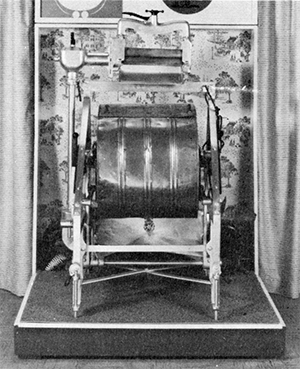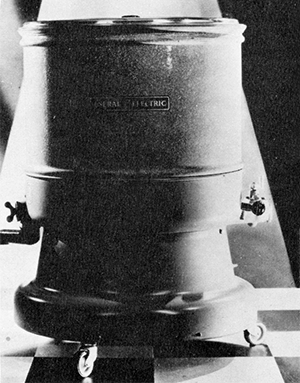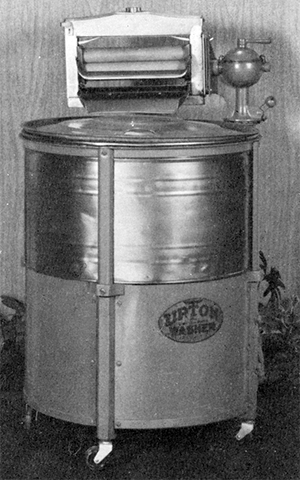
Stairway To The Grave
In an article printed in the January, 1911, DELINEATOR, Thomas A. Edison was quoted as saying, "Men know that the wash board, at best, is a kill-joy and, at worst, a moving stairway to the grave." This inventor pointed out that for only $85.00 you could purchase a washing machine which "would do a family size wash better than any woman can wash by hand."
This is his description of how the 1911 washing machine worked: "Soap the clothes. Put the clothes into the machine. Turn a valve and let in the hot water. Turn a switch and let in the electricity. Close the top to keep in the steam and smell and go about your business for about twenty minutes. Then come back and turn off the power. Open the valve at the bottom and let out the dirty water. Let in the clean water and run the machine two minutes to rinse the clothes. With the twist of the wrist, switch the power to the wringer and wring the clothes into a waiting tub of blued water on the other side. If there is any starching to be done, do it. If not, hang out the clothes to dry. That's the whole operation."
From the above description, you can see that there was not much washing action involved in that 1911 model machine. A lot of manufacturers in fact, about 107 of them, experimented with various types of action in the washing machine. One of the most interesting was called the "Locomotive." It was made in the little town of Belleville, Illinois, just outside St. Louis. It had a rectangular tub which was sent back and forth on a track and the clothes were really thrown from one side to the other with a ferocity of a bumped box car. Only two types of washing action survived the test of time, the agitator and the rotary cylinder.

During the 1920's the electric washer using a metal tub came into prominence. The one pictured above had a tub that rocked like a cradle and tumbled the clothes in a figure "8" motion. It still lacked many safety features, but the power driven wringer was much easier to use.
Agitators
In 1922, the Maytag Company offered something new for sale-a washer with an underwater agitator. It gained rapid favor because it did a thorough job of washing and because it was easy to operate. The next new item to appeal to Mrs. Homemaker was an agitator type washer/spinner, introduced by the Easy Company in 1926. This machine used centrifugal force to extract the water from clothes rather than using a wringer. By 1930, there were at least five successful agitator-type washer/spinners from which a homemaker could choose.
This method of water extraction permitted an inventive engineer to consider designing a washer in which clothes could be placed in a machine, washed, rinsed, and the water extracted with a minimum of effort on the part of the machine operator. In the 1937 Bendix introduced such a machine at the Louisiana State Fair was on the market shortly thereafter. Blackstone and Westinghouse were just introducing their automatic washers in 1941 and along came World War II, and washing machines had to give ground to the war effort. While the homemaker had to be content to use whatever washing machine she had, engineers used this period to think and perfect some of the ideas they had, so with the end of the war, the automatic washing machine really came into its own. And it brought with it a companion piece-the automatic dryer!

Note the location of the water valves in this 1930 General Electric washer. The 1930's marked the beginning of concern for safety of operation in washers but the search was still on for the type of clothes movement which would pro duce the cleanest wash.

By the mid-1930's, the laundry room had taken on a new look. The washer was modernized and the center agitator was introduced and really caught on. The washer above offered the largest capacity ever (up to that date) along with automatic cut-off switches for overloaded motor and other newly invented safety features.
Page 2 of 3 -- 1 2 3